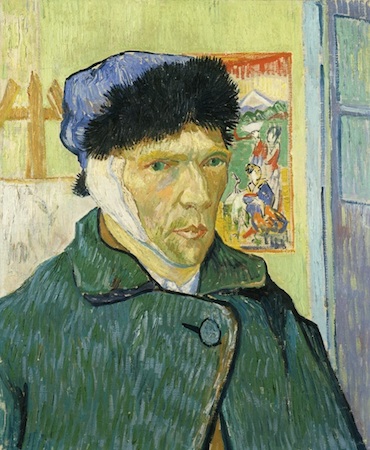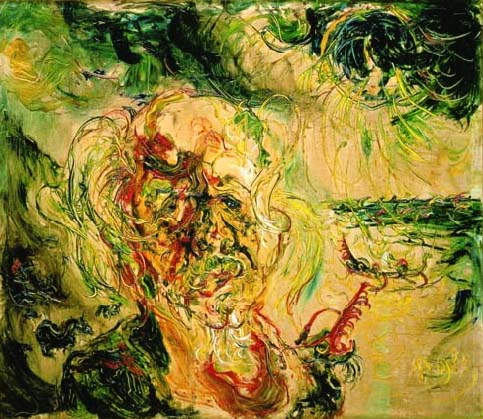
Self Portrait with Bandaged Ear, Vincent Van Gogh, 1889
Oil on canvas, 60 x 49cm

Self Portrait on Kusamba Beach, Affandi, 1953
Oil on canvas, 149.5 x 130.0cm
3 a) In “Self-portrait on Kusamba Beach” by Affandi, and old man is depicted as the only recognizable form in the painting. He has downcast eyes and a mouth of broken teeth, revealing that he is an aging artist. The painting is largely abstract but realistic to a certain extent as we could see Affandi’s face and tell that it is a self-portraiture. However, facial features and details are eliminated and replaced by an extensively expressionistic painting style. Affandi seems to be bald on the top of his had, with strands of hair at either sides of his face in a messy manner. The subject matter looks directly into the viewer’s eyes, and seems as though he is displaying great confidence and passion as an artist, and aware of his success in his occupation. However, at the same time, his downcast eyes reveals that he is also aware of the frailty of his physical self as an aging old man.
In “Self portrait with Bandaged Ear” by Vincent Van Gogh, a middle-aged man is illustrated, sitting in the centre of the canvas. He appears to be looking away, deep in contemplation. His sullen face is complemented by the black, fur hat on his head and the dark-green coat he is wearing. These elements tell the viewer that there is a feeling of coldness at his location. It could either be the weather, or the coldness in his heart. His bandaged ear appears to be the focal point of the painting and it draws our attention to it. He is probably remorseful and guilty over the incident between him and Paul Gaugain, which resulted in him cutting off part of his ear. There is an easel in the background of the painting, which seems to reveal his commitment to art despite his recent breakdown, Alternately, he could also be relating his suffering to the result of art, as if saying “look what art has done to me!”
b) In the paintings of both self portraits by the two artists, there are evidences in the painting styles of the artists. Specifically, in the brushwork and the emotions they instilled into their paintings.
In Vincent Van Gogh’s self-portrait, he has depicted himself in a subtle manner. He is much influenced by the impressionistic style and thus displayed impressionistic characteristics in his painting. Firstly, there are evident brushstrokes especially on the face and clothing of the sitter. Not much blending is done as strokes of different hues of colors are placed side by side. The sinuous and flowing brushstrokes draws our attention to his bandaged ear and arouses sensations within viewers upon looking at his painting. His painting techniques are not highly expressive but rather realistic in depicting his face.
Secondly, the colors Van Gogh chose are mostly tertiary colors. For example, a light palette of beige, brown and orange is used in illustrating his sullen face. Dark green and olive colors are used for his thick clothing to bring out the coldness in the art studio. These colors are dull and rather plain, they are not exactly expressionistic but very realistic. Van Gogh’s choice of colors gives a real sense of personal catastrophe in his painting, almost arousing the sympathy of viewers towards his bandaged ear and his personal life in which he had experienced a lot of emotional sufferings.
The composition Van Gogh chose for this portrait is one of which is realistic and organized. He sits in his art studio with an easel at the back and a painting hung on the wall. These elements together induced a quiet sense of depression in the painting, revealing the life of Van Gogh as an artist who is famous and successful but yet suffers the difficulties of life as ordinary people do.
In contrast, Affandi’s self portrait is achieved in a completely different techniques as compared with Van Gogh. His signature whirling and swirling brushstrokes are clearly evident in his painting, giving rise to his highly expressionistic style. Affandi squeezed paint directly onto the canvas and smeared with his fingers and palm. Paint was therefore applied thickly onto the canvas in the style of impasto. This technique gives a sense of dynamism and vitality in his painting.
Affandi also used expressionistic colors in his painting. Using a palette of secondary and primary colors such as red, orange, yellow and green, he portrays himself as an artist with much confidence and passion in his life. This is very different from Van Gogh’s subtle use of tertiary colors for his painting. Strong colors, with the accompaniment of daring and bold technique of applying paint, resulted in a highly expressionistic painting.
The composition of Affandi’s work is mostly abstract and unrealistic. Basically, as viewers we would only tell that there is a vague human form in the middle of the canvas. The background was very much neglected, by replacing objects with swirling colors. These colors (mostly green) complement the colors used in his face and also provides contrast, thus making the painting even more expressive on the whole.
In conclusion, Affandi and Van Gogh’s portraits are very different in terms of their techniques and styles. Van Gogh’s painting is impressionistic and subtle, while Affandi’s painting is very expressionistic with vibrant use of colors and bold techniques. Their works have a vague similarity as they both arouse emotions within viewers, enabling us to think about the artists’ lives and inner emotions. This is because both works create a certain mood of their own.
c) A good portrait reveals something unique and characteristic of the subject. In my opinion, Van Gogh’s work is more successful as a self-portrait.
He clearly illustrated his facial features and details, which greatly revealed his inner character. His eyes are sad and he appears to be deep in thought, probably facing much confusions in his life and not knowing what to do. His sullen face tells us that his is suffering with these difficulties in his life and his career as an artist. He feels remorseful and guilty for the incident between him and his friend Gaugain, thus the bandaged ear is illustrative of the inner struggle and pain within him. His clothing also shows that he is cold, probably due to the cold atmosphere in his art studio or the coldness in his heart. The latter could be because he had absolutely no feelings or at a loss of feelings at that point in time.
Affandi’s painting, however, eliminated these details. He focused on the emotional content of his paintings and adopted on a highly expressionistic style by disintegrating his face. These brought about a sense of “visual excitement” when viewers look at the painting. Nevertheless, the painting’s significance is not as strong as Van Gogh’s. The painting portrays an aging artist, who is confident and aware of his achievements in his career but yet at the same time realizes the fraility of his physical self. We do not really understand what Affandi was hoping to achieve through this portrait and what motivated him, such as the external influences, whereas for Van Gogh, it was seemingly the incident between Gaugain and him.
In conclusion, Van Gogh’s painting is more successful as a self-portrait as it reveals the inner character of the artist through his work. It is realistic and naturalistic to a certain extent, allowing the viewer to relate to and empathize with the artist, while understanding his emotional status and the story behind the painting.